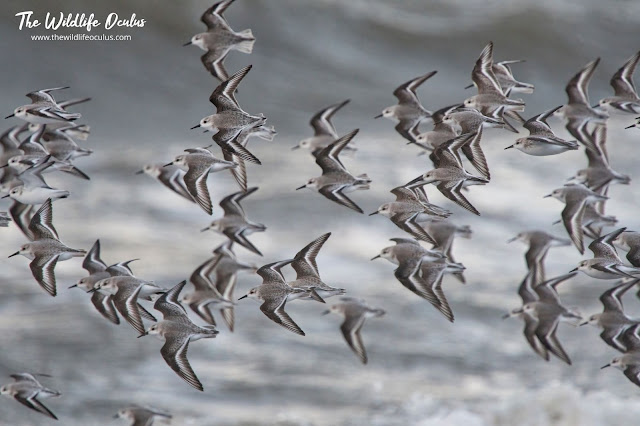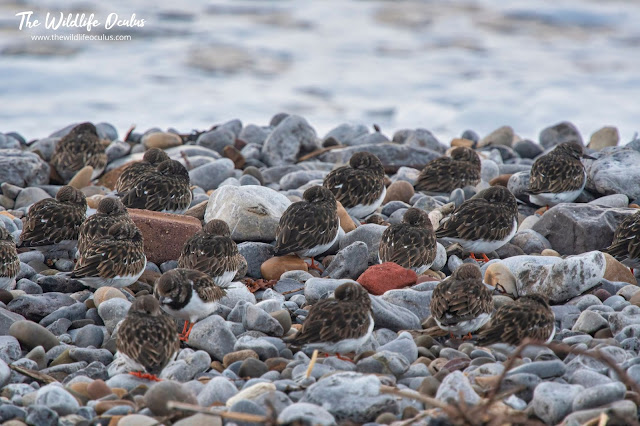A Saturday morning birding trec
 |
| Sanderlings |
One of my favourite locations in South Wales is Newton Point, Porthcawl. It's a large outcrop of rocks that is situated near the Trecco Bay Holiday Park. The point is bordered by a number of sandy bays named Trecco and Sandy Bay on its westward side and another bay to the east that leads to Newton Burrows and Merthyr Mawr.
Trecco Bay is a very popular holiday resort and can get very busy throughout the year, especially in the summer months during the peak holiday season. During the autumn and winter months it tends to be a little more relaxed and more to my liking if I am honest, as during these periods the coastline becomes home to several species of wintering waders.
High tide is the best time to watch the waders at Newton Point. As the tide starts to come in they will begin to gather on the rocks and also on the beach. The birds will congregate in small flocks and try and find somewhere to roost until the tide goes out again. The rocks of the point are probably the best place for the waders as they don't tend to get disturbed by people very much. They are quite tolerant of fishermen and birdwatchers as long as they are given some space to roost without being approached too closely. Some flocks of birds also settle on the shingle and sand of the beaches in the bays near Newton Point. These areas are not so good for the birds and the roosting flocks are often disturbed by walkers with dogs so they rarely get a lot of time to rest - especially when the high tides occur during nice weather and around mid-day when more dogs are about.
Despite the busy nature of the place the birds seem to cope ok and are pretty tolerant of people. I have been visiting Netwon Point regularly with my friend Paul Joy and on most occasions, we have had the opportunity to see a variety of species of waders in their element and quite closely.
We always give the birds a lot of respect and have found with patience and fieldcraft we can get some good results.
On Saturday Paul and I decided to go on another birding trek to Newton Point. I have been trying to visit for a while since the new year but just haven't been able to find a weekend where the tide times have been favourable. The weather forecast was a little dodgy. High winds and rain were expected from about Mid-Day so Paul and I were hoping for some calm before the storm arrived.
 |
| Rain to start the day |
 |
| Sunrise |
When we arrived just before dawn dark clouds had moved in overhead and it started to rain. To the east, there was a big band of orange but it looked like the rising sun was fighting a losing battle against the storm clouds that were moving in from the West.
We decided to head to Gregs for breakfast rather than get completely soaked and enjoy a coffee and a bacon roll whilst waiting out the wave of bad weather.
By 8 am the rain had stopped and even some blue sky had appeared between the clouds.
 |
| Some sunshine at Trecco Bay |
It was quite a high tide and most of the sandy beach had been covered by the time we parked up at Newton Point. The waves were being whipped up by a keen wind, ideal conditions for surfing and there were already a couple of very brave individuals testing their skills against the elements.
I scanned the rocks of the point and Trecco Bay and soon picked up a flock of waders roosting on the last of the rocks on the bay.
I headed off to take a look at them and Paul Joy decided to set up his camera kit on what was left of the shingle beach and so some time-lapse photography.
I discovered that the flock of roosting birds I had seen as I got closer to them consisted of Grey Plovers, Oystercatchers, Turnstones, Sanderlings, Dunlins and Ringed Plovers.
 |
| Grey Plover |
This was the first time I had seen Grey Plovers at Newton Point. They have huge eyes compared to some other species of waders. When they fly the Grey Plovers have very distinctive black markings where the wing joins the body knowns as "Hairy Armpits". This plumage is always useful in identifying them as they can look very similar in winter to Golden Plovers who lack hairy armpits.
Grey Plovers are a little less tolerant to being approached than some other wader species - their safety zone being that much wider than say Turnstones and Sanderlings so you have to be very careful when creeping upon them as they will soon take flight.
I spent quite a bit of time moving up the shingle to them on my knees only to just get within a comfortable range, only for a dog to appear from nowhere on the beach and off the whole flock would go, hurtling away flying low off the waves cross the bay.
 |
| Sanderlings, Turnstones and Ringed Plovers |
 |
| Turnstones, Grey Plover and Sanderling |
 |
| Sanderlings sweep low across the sea |
Eventually, once the dog threat had passed the flock would return to their favoured spot on the beach and settle down again. I got lucky quite on a number of occasions and they landed quite close to me.
You have to marvel at their camouflage. Even the bold ultra-bright coloured Sanderlings blend in with the shingles and smooth rock that litter the beach.
 |
| Roosting waders |
 |
| Sanderlings and Turnstones |
 |
| Turnstones |
Whist kneeling down low watching the roosting birds I noticed a single wader suddenly drop out of the sky from nowhere and settle on one of the nearby rocks. I glanced at it slowly and was surprised to see that it was a Purple Sandpiper. Now that was a great sighting and something that I was hoping for. My first sighting of one of these waders in Wales. It was only in January this year that I saw one for the first time ever at Portishead, Bristol so finding a bird at Newton Point was an excellent result.
 |
| Out of the blue, a single Purple Sandpiper puts in an appearance. |
About twenty minutes passed and the waders had begun to get really relaxed and were bedding down until the tide went out. Unfortunately for them, yet again they were disturbed by a rather excited dog and up they went. The Sanderling and Dunlin flock went really for it and started a mini-murmuration whizzing past me quite closely as I sat there on the beach.
The aerial display was fabulous and just up my street as I love watching wader flocks in flight.
 |
| Sanderlings take flight |
Paul and I found a nice spot just outside the Grey Plovers safety zone and we settled down to take some photographs. The birds were very accommodating and seemed to have accepted we posed no immediate threat to them.
 |
| Grey Plovers keep watch |
 |
| Turnstone |
 |
| Redshank |
As I watched the Grey Plovers something moved to my left and a short distance away from me was a small flock of my little purple friends that keep dropping in on me! I counted seven Purple Sandpipers in all. The birds keep very close to the water's edge and were sheltering from the worst of the waves and the wind. I signalled to Paul what I had found and we enjoyed watching the Purple Sandpipers roost - they slept, pretended and occasionally foraged amongst the rocks.
Finding the Purple Sandpipers at Newton was great and it was nice to watch them without causing them any disturbance.
 |
| "Me in my element ". Picture Courtesy of Paul Joy. |
 |
| Purple Sandpiper |
 |
| A Purple Sandpiper keeps an eye on me |
 |
| Purple Sandpiper |
 |
| Taking a quick nap - roosting Purple Sandpiper |
After about thirty minutes Paul and I even had some sunshine to warm us up which was nice. More birds arrived at the point and joined the roost. A big flock of Sanderlings landed close to me on the rocks and for a time settled down almost oblivious to my presence.
I watched them squabble and jostle over their position in the flock on a particular rock and they eventually got comfortable and started to rest up.
 |
| The Sanderlings come in to roost |
 |
| Sanderlings roosting |
Eventually, the main flock decided to take flight once again and they shot en masse across the bay heading towards Sandy Bay.
Paul and I had now taken more than enough pictures and it had been a great morning of birdwatching. It now was time to pack up and get some lunch - Fish and Chips from Beales - yummy :)
 |
| A Happy Mr Joy - I do my best to keep him well fed! |
Bird List
- Sanderling
- Turnstone
- Dunlin
- Grey Plover
- Redshank
- Oystercatcher
- Purple Sandpiper
- Rock Pippit
- Carrion Crow
- Cormorant
- Herring Gull
- Black-Headed Gull
All records were reported to BTO via Birdtrack.



A very enjoyable read. Well illustrated with quality photos.
ReplyDeleteThank you for taking the time to comment. Many Thanks for the feedback.
DeleteThank you for taking the time to comment. Many Thanks for the feedback.
Delete